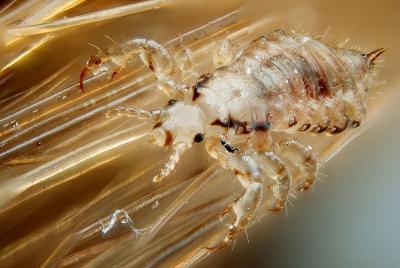Head Lice: The Basics

What are head lice?
Head lice are small insects that live on the human scalp. Adult lice are 2 - 3 mm long and tan to gray in color. They attach their eggs (or nits) to hair shafts.
Fun Fact: The only host of head lice is humans. Dogs, cats, and other animals do not get or spread lice.
How do head lice spread?
In the United States head lice most commonly affect preschool and elementary school-age children. Head lice spread primarily through head to head contact. It is possible but rare for lice to spread by contact with hair brushes, combs, or hats. Head lice cannot survive for more than a day away from the scalp. Fortunately, they cannot jump or fly.
Fun Fact: In the United States head lice infestation is less common among African Americans. It is thought this is because the lice that live in the US have claws that are better adapted for grasping some hair types than others.
What are symptoms of head lice?
The most common symptom of head lice infestation is itching, but they can be asymptomatic. The itching is most pronounced behind the ears and in the back of the neck. Itching can persist for a few weeks after the lice have been successfully treated.
Fun Fact: It can take as long as 4 - 6 weeks after infestation for itching to develop.
How can I check for head lice?
Lice avoid light and can be difficult to spot. Nits are firmly attached to a hair (unlike dandruff which can be easily brushed off). It is important to note that the presence of nits does not necessarily mean that there is an active infestation as the nits will remain attached even after successful treatment.
Fun Fact: Absence of live lice is the best way to know that the infestation has been successfully treated.
How are lice treated?
There are a number of effective treatments for head lice. Three options are available over-the-counter: permethrin 1% lotion, pyrethrin-based shampoo, and ivermectin 0.5% lotion. There are also several prescription treatments. A growing number of head lice have developed resistance to some of the available treatments. If the initial treatment is not successful an alternative may be needed.
In addition, you can wet your child’s hair and use a fine-toothed comb to comb out the lice and nits. This method generally does not get rid of lice on its own but can be used along with one of the above treatments. It is not necessary to remove all the nits to successfully treat lice.
Fun Fact: The American Academy of Pediatrics recommends against excluding children from school if they have lice.
What else should I do to get rid of head lice?
Any clothing, bedding, or towels that were used in the two days prior to treatment should be washed with hot water and dried on high heat. Items that cannot be washed can be sealed in a plastic bag for 2 weeks or dry cleaned. Furniture can be vacuumed.
Fun Fact: Lice and their eggs are killed by exposure to temperatures greater than 130 degrees F for 5 minutes.
